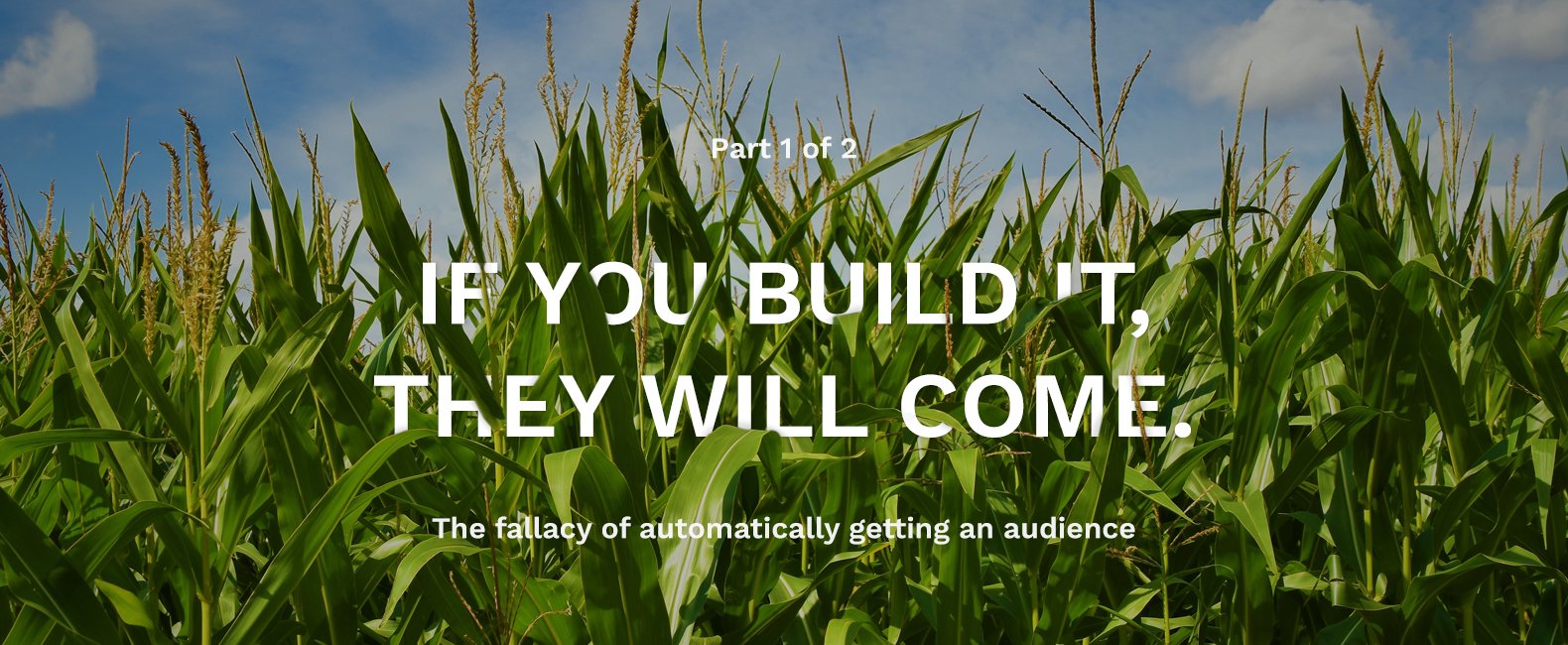© 2025 Flywheel Co.
Marketing — 05.19.20
Field of Dreams - The automatic audience fallacy

In this two-part series we'll discuss why launching a website or web application won't automatically gain an audience. The common misconception is that "if you build it, they will come". That may have been true in "Field of Dreams", but in the modern web you need to actively engage with your customer base and make improvements over time. Building it is just the first step, getting an audience and maintaining it is the long-haul.
Part 1 : The fallacy of automatically getting an audience
Back in 1972, Ray Kinsella (Kevin Costner) was a farmer in Iowa whose father was a devoted baseball fan. In the movie "Field of Dreams", Ray hears a voice while walking through his cornfield that whispers “If you build it, he will come”. (Let’s get something out of the way for you Field of Dreams purists. The actual quote from the movie doesn’t perfectly fit my analogy so let’s call this artistic license when I say “If you build it, they will come”.) This voice drives Ray to build a baseball diamond on his land, believing that somehow this whisper is calling him to build a field that Shoeless Joe Jackson can play on again; a player Ray’s father idolized.
Spoiler Alert - In the end, a dream team of past all-stars show up to play on this majestic diamond in an Iowa cornfield. People thought he was crazy, he sacrificed land he would have used for crops, and he pushed forward despite reason and common sense… but in the end, they came. I know you’re not reading this for a review of Field of Dreams but stick with me. I had to set the premise.
In this series I’ll talk about why that quote, however hopeful it may be, doesn’t fit with the reality of the modern internet. Getting users, customers, and qualified traffic to your website or web application is more than blindly following whispers and crossing your fingers. Even the almighty power of Google won’t automatically bring the people you want to your website unless you take the right steps and put the work in. It worked for Ray in the 70’s, but in 2020 building the baseball field is just the beginning.
Expectation vs Reality : Why building it isn’t enough
We talk with a lot of businesses in a number of scenarios whether it’s the sales process, a long term relationship, as a consultant, or anywhere in between. Our expertise, at its core, is helping our clients navigate the world of branding, web development, and web-based software for their businesses. For the most part this article will be focused on the web related aspects but a lot of this applies to how you would approach your brand from a holistic perspective.
The expectation
Now this isn’t cut-and-dry and it’s certainly not always the case, but in general, there is the hope that simply putting your idea online will automatically make a business and will automatically bring in the customers or users you need to thrive. A lot of the thoughts are hopeful and positive. “Our base goal is to hit 1,000 registered users in 60 days”, or “We’re aiming to see 45 sales in the first month.” It doesn’t necessarily matter what the application is or what you’re selling… there is typically the expectation of a certain level of success when you start or completely shift your business.
It’s easy to get caught up in the “if you build it, they will come” mindset. The truth is this: it takes planning and it takes work to draw in the users and customers you want. You need the field to play on, but you’re playing the odds if you expected the all-stars to come from the cornfields and the odds aren’t in your favor.
- Many people expect that by creating a website or application their customer base will automatically find them.
- Playing the odds and crossing your fingers isn’t the smartest idea.
- Driving traffic to your site takes work (or money, or both). Building your idea is just the start.
The reality
As mentioned above, the truth is that there is more work to be done after you’ve built your proverbial baseball field. Yes, there are those diamond-in-the-rough (had enough movie references yet?) cases where the simple fact of existing means success but those are few and very, very far between. What comes after clearing the land, chalking the lines, building the mound, and creating dugouts is letting the world know you’re ready to play ball. There are a number of different ways to drive traffic to your site or application and there's no silver bullet. There are a lot of factors at play.
- Your website or application just being online won’t drive traffic on its own.
- Getting your website or application online is just the first step.
- Driving traffic to your site isn’t guaranteed or automatic.
How do we tackle the challenge of getting users aware of our site, business, or application?
These next sections are things you can and should do to drive traffic to your brand online. Whether it’s a website, e-commerce site, or web application you can use these tactics to significantly increase your chances of bringing in new users that hopefully turn into customers. These are in no particular order. It is debatable about which of these are more important than the other. Search Engine Optimization (SEO) specialists would say organic and paid search, designers would say brand and messaging, programmers would say page speed and user experience… It’s a mixed bag. Your best bet is to evaluate all options and do as many as possible.
Content is king. What you say and how you say it matters.
Let’s start with one of the most important factors. Content. Is. King. It’s true, and here’s why.

The way people find your website or application organically is based on the information you provide the world… and by the world, I mean search engines. For this section we’re focusing on search engine optimization. You, me, and your neighbor are the same. We all use search engines to find the information we need. Search engines are smart and getting smarter every day. The goal of every search engine's business and the profit machines behind them are to send you, the user, to the website with the best information to answer the question you’re asking. If they do it right, you’ll keep coming back to them for the answers you’re looking for.
SEO and where it all started; a very abbreviated version
Let me take you back a few years (or more). Search engines were “dumb”. I use that term very lightly because the technology behind them, even then, was groundbreaking. Essentially, these search engines were programs that endlessly scoured the internet for words that matched the words you typed as a search query. In an over simplified example, if you searched for baseball, the website that had the word “baseball” the most was the one you would get as a result.
Back then websites didn’t exist in the same way they do now… from a technology perspective and from sheer volume. These days it’s easier than ever to create a website and put your thoughts online. This quickly became a problem for search engines. You’ve probably already figured out where I’m headed with this. Websites would just add the words they wanted you to find as frequently as possible and just like that, they had traffic. This is known as “keyword stuffing” and it turned into an issue for search engines. No longer did the website with the most frequent use of your search term actually mean it provided the best information for you, or that it would be the highest quality information.
- Search engines weren’t as smart as they are now.
- “Keyword stuffing” quickly became an issue.
- More and more websites were popping up every hour, saturating the web.
What search in the 2020s looks like; a very, very abbreviated version
Now that we’ve taken a quick trip down memory lane, let’s talk in broad terms about how search engines evaluate websites in modern times. To be sure, this isn’t a fully comprehensive list of how these search companies apply relevancy to your content. That’s a dissertation of its own, if not multiple, but I’ll distill it down. Search engines look for the quality of your content and they determine what that means using a lot of different factors. A few of these factors include :
- Is the content on your site relevant to the search query?
- Do the people that visit your site from their search query stay or do they leave immediately?
- Does your site load quickly? (People hate to wait.)
- Is your site optimized for mobile devices? (We live in the age of smartphones.)
- Do other reputable websites link to your site? (It’s like a buddy vouching for you.)
- Do people return to your site for more information? (Was it worth coming back?)
- Is your site outdated? That is to say… do you maintain it? (Copyright 2015 is a bad look.)
All of these things, and more, play into the “score” that search engines will apply to your website. This score fluctuates and it’s easier to lose the favor of search engines than it is to gain it. Just stuffing keywords into your content won't do the trick.
Enough about search engines
I’ll close this section out by saying that, as the title says, content is king. Words count but it’s what you are saying that matters. How you say it matters. Of course you want to have the words you think your users are searching for but you can’t simply repeat those words. You need to mean it. You need to say something of substance. You need to consider and focus on the fact that a human on the other end of the internet will be reading what you have to say and you should intend for them to be engaged and learn from your content. That’s how you start to prove the worth of your website to search engines.
- Search engines are smart and getting smarter every day
- Many, many factors play into how your site is respected by search engines
- Your words still matter, but your content as a whole matters more
- Be human, write for other humans
Let’s talk about blogs and website updates in general
 Often times we’ll talk to a client who either mentions wanting a blog or we suggest it to them. The first question we ask is how they intend to use it. There’s a strange risk vs. reward factor in a blog. It can’t be an afterthought and it can’t be forgotten. In this section I’ll touch on how a blog (and general website updates) can be beneficial but how it can come back to bite you if you don’t maintain it. I’ll also touch on website updates in general outside of scheduled (or not) blog posts.
Often times we’ll talk to a client who either mentions wanting a blog or we suggest it to them. The first question we ask is how they intend to use it. There’s a strange risk vs. reward factor in a blog. It can’t be an afterthought and it can’t be forgotten. In this section I’ll touch on how a blog (and general website updates) can be beneficial but how it can come back to bite you if you don’t maintain it. I’ll also touch on website updates in general outside of scheduled (or not) blog posts.
Blogs : The good parts
If they don’t already ask for it we often recommend, where it’s suitable, that our clients have a blog. A mechanism for them to speak to their audience through their website is really nice. I’m sure everyone reading this knows what a blog is so I’ll skip to the point. Blog articles let you show expertise in your industry. When a user or potential customer is looking into your business you want to show that you are knowledgable. Articles written about industry topics can help to prove your competence and engage your customers. Additionally, you get to show a bit of personality whether that’s the personality of each author or the personality of your business as a whole. You get to decide the voice and that’s powerful.
- Speak directly to your customers or users
- Show expertise and competence
- Let the people engaging with your business see some personality
Search engines are happier with fresh, relevant content
Another aspect of posting with regularity is the sheer fact that you are updating the content on your website. Search engines will be interested in sending customers to websites that are maintained. Granted, this alone won’t result in “heavy gains.” It’s playing the long-game that will prove the value of frequent updates. You can “talk” to your audience, customers, and potential customers about current topics or events in your industry or about your application. It’s all about the voice you choose to speak with. For example, the Flywheel Co. blog includes industry-related posts as well as more personality-related posts. You can see the differences in writing between authors and we like that. Part of what it means to work with Flywheel is to work closely with us as a team, so understanding who we are is important when choosing the right team.
- Show personality and give an insight into your business
- Keep your website fresh
- Talk about content relevant to the current times
Blogs : The bad parts
This might be the point where you’re wondering what the downside of a blog is. The question of “How could having a blog hurt me?” can be answered pretty quickly. If you don’t update your blog it could hurt your brand and impact your favorability with search engines.
The usual suspect : Writing ain’t easy and it takes time.
The first step of a blog causing problems is not updating it enough… or at all. Let me hit you with some cold, hard truth; blogs are hard to maintain. Despite your best efforts and even having the best of intentions, it’s still very hard to find time to write meaningful blog posts. For a lot of people it’s hard to write anything in general. Unless you have dedicated staff or a position appointed to posting to the blog, it’ll soon overwhelm the unexcited. Make sure you really will make a point to write blog posts with some sort of regularity.
- It’s hard to find the time to write
- Writing may not come naturally and can be a barrier
- It is just another thing to add to your workload
Anybody home? Out of date blogs can hurt your brand perception
From a brand perspective, you might look like you don’t care about your business. Are you open? Are you relevant? Is anyone “behind the wheel” here? These are all questions that can cross a potential customer’s mind when looking at a blog whose last post is ages ago or who barely has anything to say. This argument is primarily that you could be damaging your business’s image. It becomes a perception issue that can cause you to lose users or customers that otherwise might have engaged with you.
- Negative impacts on the perception of your brand
- If you don’t update you may look like an inactive business
Make updates or get left behind
On a more technical level, you are doing yourself a disservice by not updating your website. In general, content updates are a positive when they’re focused around data and adapting to your business. A blog is a great way to do that without rebuilding pages or engaging with a developer. Don’t get me wrong, adding new pages, reworking your mobile user experience, and more substantial changes are definitely a positive thing when it’s appropriate. Search engines want to send their customers to the most relevant information. If your information is 2 - 3+ years old, there’s a good chance it’s not the most relevant anymore. This is a very nuanced scenario, though. In general, you’ll have more benefit with SEO by maintaining your blog, especially when targeting specific topics.
- Search engines are more interested in active websites
- Having the most recent, relevant information is valuable
- More substantial changes outside of blog posts can be very positive
Part 1 : In summary
Websites in general are easier to make than ever. Web applications are a dime a dozen. Creating your website or application is the first step to getting an audience but it's not going to do it on its own. In "Field of Dreams", Ray listened to his gut (or cornfield whispers) and ignored everyone that told him he was crazy. It's a lovely idea, but it's not reality when we're talking about attracting users and customers.
There are steps you can take, though. We've talked about the importance of content and how you convey that content, how search engines assign value to your website or application, and how a blog can help and/or hurt your chances at fresh traffic. There are more options in your tool chest, though.
What's in Part 2?
In part 2 of this series we'll go over more ways that you can improve your chances at gaining and retaining qualified customers. Interacting with your potential audience, targeted ads, and an enthusiasm and passion for your business are all things that can help your brand, website, and application.
- Engage with relevant online and offline communities.
- Pay your way into an audience with ads.
- Enthusiasm matters. If you care about your product, your customers are more likely to care as well.
Read Part 2 - Gaining the right audience for your website or application
Want to know more?
You can follow Flywheel Co. on Twitter, Instagram, and check out our other blog posts!

Co-founder & Lead Programmer
Matt Higgins
Matt is a co-founder, creative director, and programmer at Flywheel. He's made literally tens of people laugh in his lifetime and is always looking for the next problem to solve.

